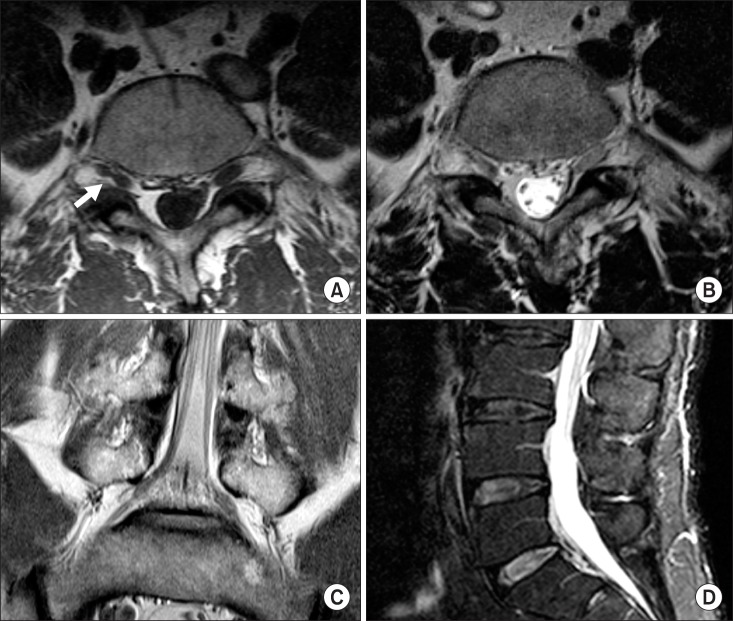Korean J Pain.
2018 Jan;31(1):54-57. 10.3344/kjp.2018.31.1.54.
Lumbar burner and stinger syndrome in an elderly athlete
- Affiliations
-
- 1Department of Orthopaedics, Physical Medicine and Rehabilitation, University Hospital, LMU Munich, Germany. Veronika.Wegener@med.uni-muenchen.de
- 2Radiology in Munich-Harlaching, Munich, Germany.
- KMID: 2400909
- DOI: http://doi.org/10.3344/kjp.2018.31.1.54
Abstract
- Burner or stinger syndrome is a rare sports injury caused by direct or indirect trauma during high-speed or contact sports mainly in young athletes. It affects peripheral nerves, plexus trunks or spinal nerve roots, causing paralysis, paresthesia and pain. We report the case of a 57-year-old male athlete suffering from burner syndrome related to a lumbar nerve root. He presented with prolonged pain and partial paralysis of the right leg after a skewed landing during the long jump. He was initially misdiagnosed since the first magnet resonance imaging was normal whereas electromyography showed denervation. The insurance company refused to pay damage claims. Partial recovery was achieved by pain medication and physiotherapy. Burner syndrome is an injury of physically active individuals of any age and may appear in the cervical and lumbar area. MRI may be normal due to the lack of complete nerve transection, but electromyography typically shows pathologic results.
MeSH Terms
Figure
Reference
-
1. Krivickas LS, Wilbourn AJ. Peripheral nerve injuries in athletes: a case series of over 200 injuries. Semin Neurol. 2000; 20:225–232. PMID: 10946743.
Article2. Kuhlman GS, McKeag DB. The “burner”: a common nerve injury in contact sports. Am Fam Physician. 1999; 60:2035–2040. 2042PMID: 10569506.3. Speer KP, Bassett FH 3rd. The prolonged burner syndrome. Am J Sports Med. 1990; 18:591–594. PMID: 2285087.
Article4. Feinberg JH. Burners and stingers. Phys Med Rehabil Clin N Am. 2000; 11:771–784. PMID: 11092018.
Article5. Hirasawa Y, Sakakida K. Sports and peripheral nerve injury. Am J Sports Med. 1983; 11:420–426. PMID: 6650720.
Article6. Nissen SJ, Laskowski ER, Rizzo TD Jr. Burner syndrome: recognition and rehabilitation. Phys Sportsmed. 1996; 24:57–64.7. Feinberg JH, Nadler SF, Krivickas LS. Peripheral nerve injuries in the athlete. Sports Med. 1997; 24:385–408. PMID: 9421863.
Article8. Lorei MP, Hershman EB. Peripheral nerve injuries in athletes. Treatment and prevention. Sports Med. 1993; 16:130–147. PMID: 8378668.9. Fuller CW, Brooks JH, Kemp SP. Spinal injuries in professional rugby union: a prospective cohort study. Clin J Sport Med. 2007; 17:10–16. PMID: 17304000.
Article10. Choi EJ, Choi YM, Jang EJ, Kim JY, Kim TK, Kim KH. Neural ablation and regeneration in pain practice. Korean J Pain. 2016; 29:3–11. PMID: 26839664.
Article11. Hay JG. Citius, altius, longius (faster, higher, longer): the biomechanics of jumping for distance. J Biomech. 1993; 26(Suppl 1):7–21. PMID: 8505354.
Article


